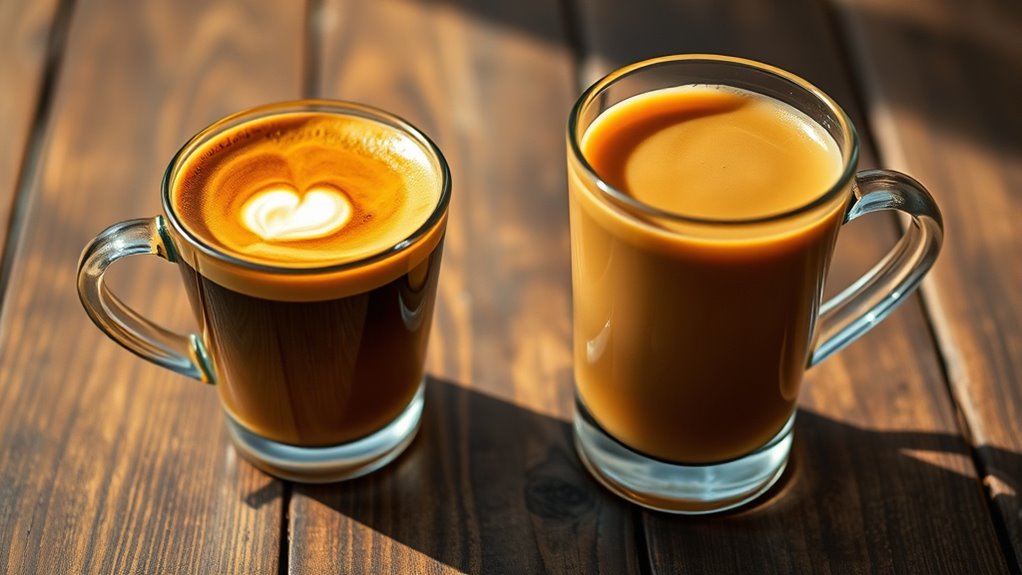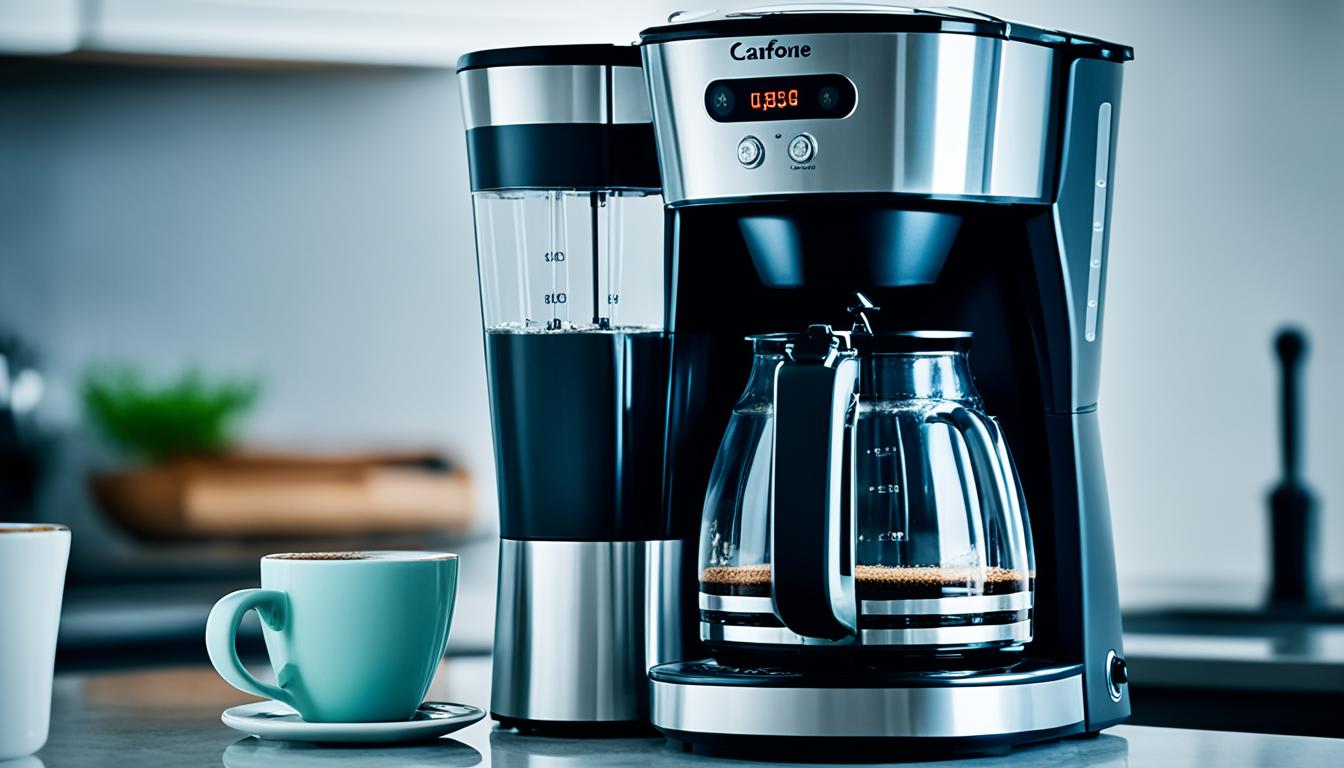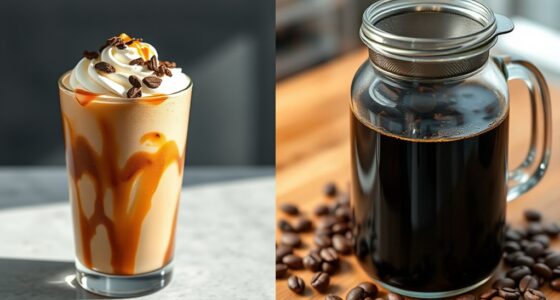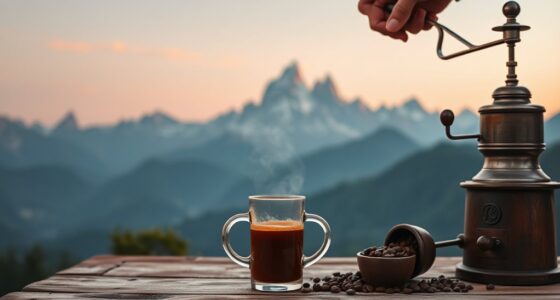Many believe that lungo is just a larger, weaker espresso, but the key difference lies in the brewing process: lungo uses a longer extraction time, resulting in a milder flavor and more volume. However, the quality depends on proper technique, not just shot size. Caffeine content varies based on brewing variables, not volume alone. To uncover more truths about these brewing styles, keep exploring the facts behind each cup.
Key Takeaways
- Espresso is a concentrated shot brewed with high pressure, while lungo is a larger, milder extraction with longer brewing time.
- Longer extraction in lungo can cause bitterness if not properly controlled; it doesn’t automatically mean better quality.
- Both drinks’ flavors are influenced by bean origin and brewing temperature, not just shot size.
- Espresso has higher caffeine concentration per ounce, but lungo delivers a milder caffeine dose due to larger volume.
- Quality depends on brewing technique, including grind size and extraction time, not solely on shot length or bean type.
What Defines an Espresso?
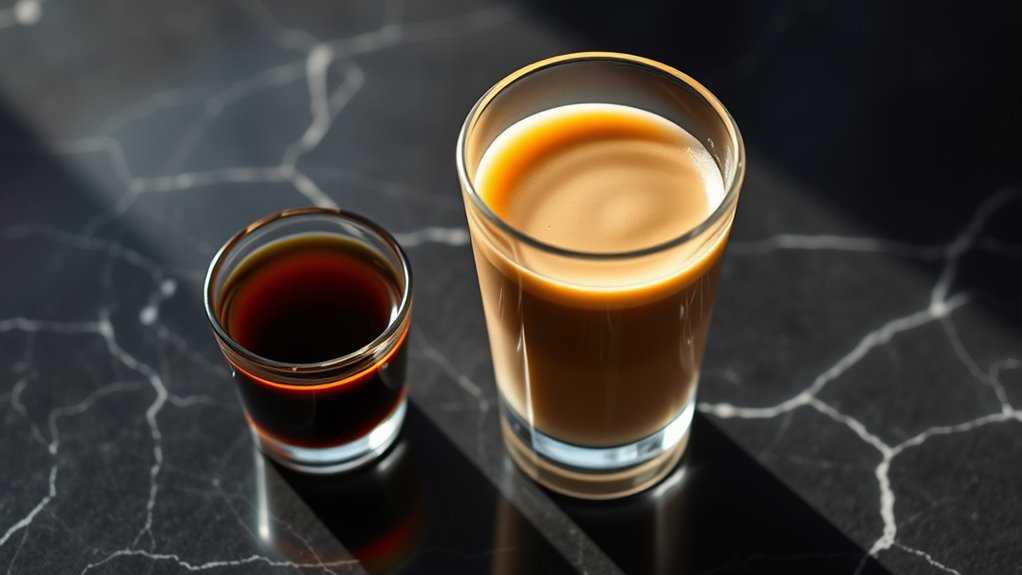
An espresso is a concentrated coffee beverage brewed by forcing hot water under high pressure through finely-ground coffee beans. This coffee brewing method produces a rich, bold flavor with a thick crema on top. When you make an espresso, the process extracts more oils and solids, resulting in a thicker, more intense taste than drip coffee. The caffeine content in an espresso is higher per ounce, giving you a quick caffeine boost, though the overall amount depends on serving size. Because of its unique brewing process, espresso is characterized by its strong aroma and full-bodied flavor. It’s often the base for other coffee drinks, but on its own, it offers a potent shot of coffee that’s both flavorful and energizing. Brewing process also influences the flavor profile and aroma of the final beverage.
The Making of a Lungo: How It Differs
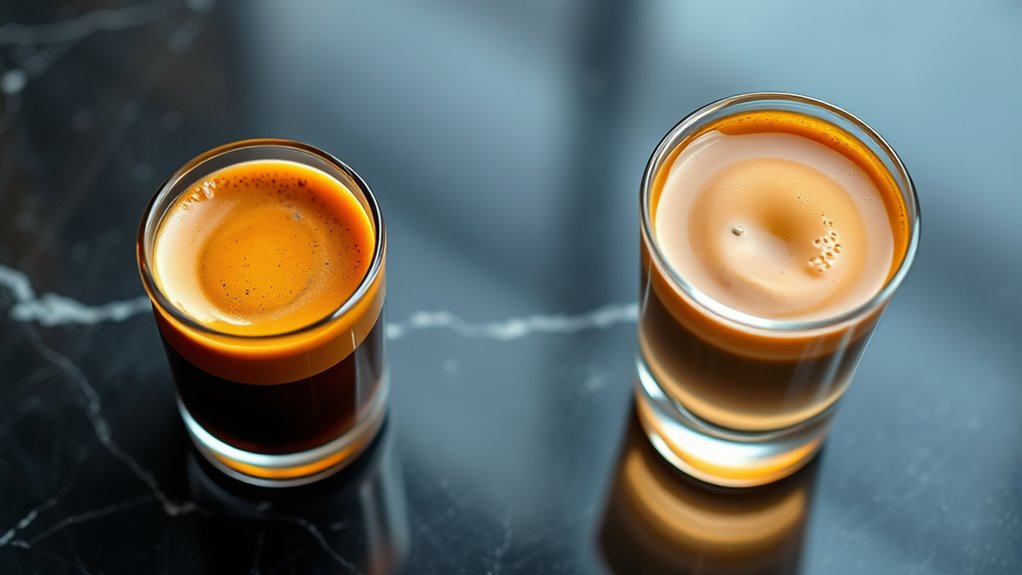
While an espresso is brewed under high pressure with finely ground coffee for a small, concentrated shot, a lungo takes a different approach, emphasizing a longer extraction process. To make a lungo, you typically increase the extraction time, allowing water to pass through the coffee grounds more slowly. This extended process requires careful control of brew temperature; if it’s too high or low, it can affect flavor and consistency. The longer extraction allows more compounds to dissolve, resulting in a larger volume and a milder, more diluted taste compared to espresso. By adjusting the brew temperature and extending extraction time, you create a lungo with distinct characteristics, offering a different experience than the quick, intense shot of espresso. Proper brewing technique is essential to achieve the desired flavor profile and consistency in a lungo.
Taste Profiles: Myth Vs Reality
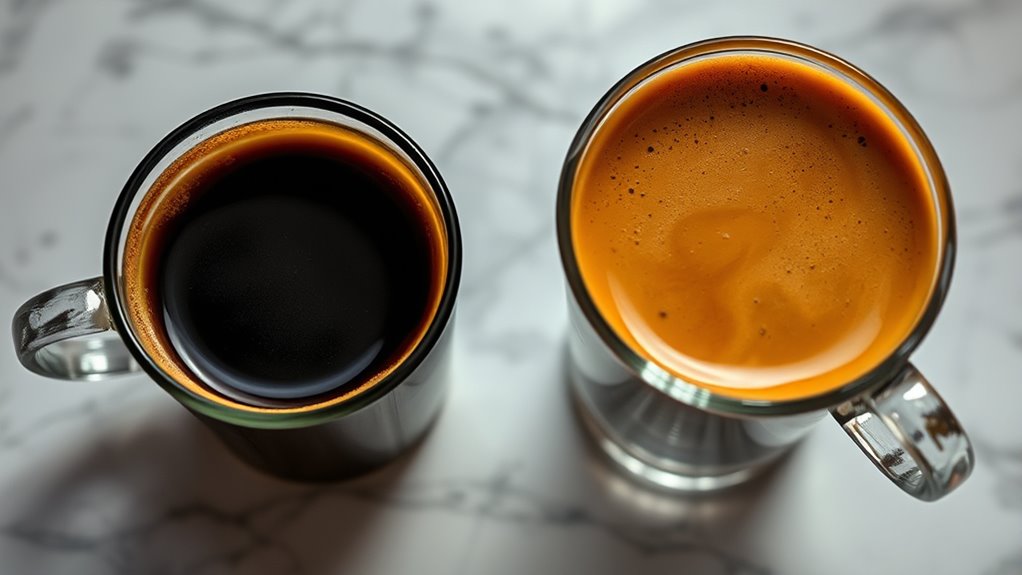
Many people believe that espresso and lungo have vastly different flavors, but the reality is more nuanced. Your taste experience depends heavily on bean origin, which influences the flavor profile regardless of the shot size. A bean from Ethiopia might bring bright, fruity notes in both drinks, while a South American bean could add nuttiness. Brewing temperature also plays a vital role; higher temperatures extract more oils and flavors, affecting the taste. Since lungo involves a longer extraction, some assume it’s more bitter or diluted, but if brewed at the right temperature, it can maintain a rich, balanced flavor. Additionally, caffeine content varies with extraction time, which can subtly influence the perceived intensity of the flavor. Ultimately, the difference in taste is subtle and shaped by both bean origin and brewing temperature, rather than just shot length.
Health Implications of Espresso and Lungo
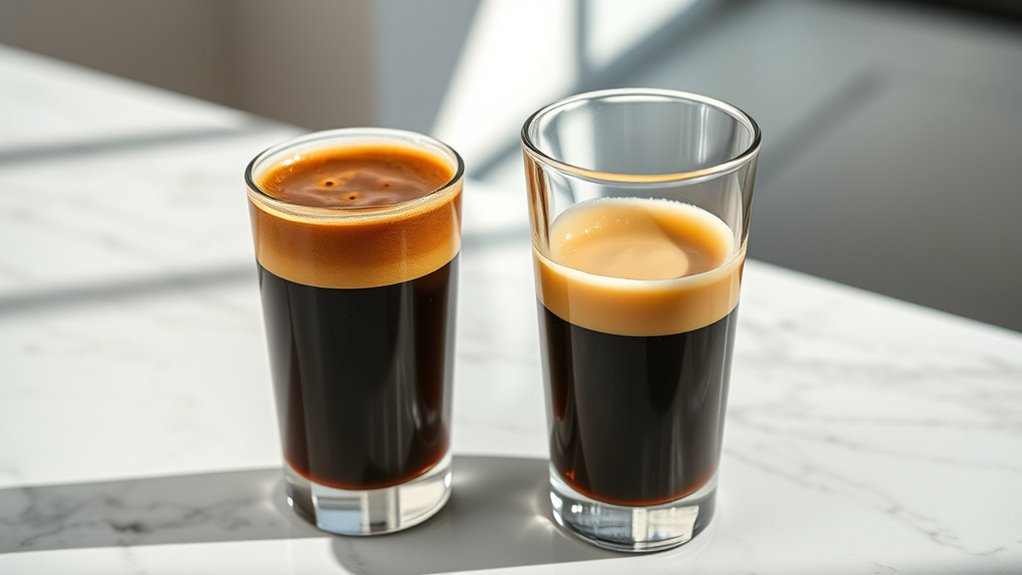
Choosing between espresso and lungo can impact your health, primarily because of their caffeine content and acidity levels. Espresso generally has a higher caffeine concentration per ounce, which can affect your heart health if consumed excessively. Lungo, with its larger volume, offers a milder caffeine dose but still influences your overall intake. Consider these points:
- Caffeine Content: Higher in espresso, increasing alertness but risking heart issues if overdone.
- Acidity Levels: Both can cause stomach discomfort and acid reflux, especially for sensitive individuals.
- Heart Health: Moderate consumption of either drink can be safe, but excessive caffeine may elevate blood pressure and stress your heart.
Being mindful of your intake helps you enjoy your coffee without compromising your health.
Common Misconceptions About Preparation and Quality

A common misconception is that the quality of espresso and lungo depends solely on the type of beans used, but preparation techniques are equally crucial. Brewing techniques, such as grind size, tamping pressure, and extraction time, directly influence flavor and overall quality. Many believe that longer extraction automatically results in a better lungo, but if done improperly, it can lead to over-extraction and bitterness. Additionally, people often assume that lungo has more caffeine because of its larger volume; however, caffeine content depends more on brewing variables and beans, not just size. Proper Brewing techniques are essential for achieving optimal flavor and caffeine levels, dispelling myths that quality and caffeine are solely dictated by volume or bean choice.
Frequently Asked Questions
Can You Make a Lungo From an Espresso Machine?
Yes, you can make a lungo with your espresso machine by simply extracting a longer shot, usually 60ml or more. This process allows you to showcase coffee art, highlighting the crema’s richness. The bean origin influences flavor, which becomes more pronounced in a lungo due to the extended extraction. Be mindful that using high-quality beans and adjusting grind size helps achieve a balanced, flavorful lungo that’s enjoyable and visually appealing.
Are Lungo Shots More Caffeine-Rich Than Espresso?
Think of your coffee as a story, with each shot revealing a different chapter. Lungo shots generally have more caffeine content because they’re brewed with more water, extending the extraction process. However, their flavor profile becomes more diluted and less intense than espresso. So, if you’re after a caffeine boost, lungo might be your go-to, but if you crave rich flavor, espresso keeps its crown.
Does Brewing Time Affect Flavor More Than Grind Size?
Brewing time impacts flavor more than grind size because longer brew times extract more flavors and compounds, affecting the taste considerably. While grind size influences extraction speed, adjusting brew time allows you to fine-tune flavor profiles precisely. You should focus on controlling brew time to enhance flavor, especially if you prefer a richer, more balanced cup. Grind size still matters, but it’s secondary to the overall influence of brew time on flavor development.
Is a Lungo Always Stronger Than a Standard Espresso?
A lungo isn’t always stronger than a standard espresso; it’s more like a marathon runner, stretched out for endurance. Brew strength depends on the extraction process, not just volume. When you extend the brewing time for a lungo, you might extract more flavors, but it can also lead to a more bitter taste. So, a lungo’s strength varies based on how it’s brewed, not just its size.
How Does Water Temperature Influence Taste in Both Drinks?
Water temperature plays a vital role in shaping the taste of both espresso and lungo. When water temperature is too high or too low, it affects extraction quality, resulting in dull or overly bitter flavors. Ideally, you want a consistent, ideal temperature to guarantee the coffee’s oils and flavors are properly extracted. This balance enhances the richness of espresso and the smoothness of lungo, giving you a better overall drinking experience.
Conclusion
Think of espresso as the sun’s bold, intense rays, fueling your day with strength. Lungo, on the other hand, is like dawn’s gentle glow—longer, milder, yet equally essential. Both hold their unique place in your coffee journey, shaping your experience with each sip. Embrace the symbolism in their differences, and discover that whether you chase the intensity or the serenity, your perfect coffee moment is entirely yours to define.
